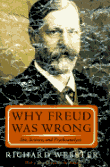Why Freud Was Wrong: Sin, Science and Psychoanalysis

|
Author: Richard Webster |
Richard Webster's Why Freud was Wrong is a measured critique of Sigmund Freud's scientific - or less than scientific - approach to the human mind and psychotherapy.
Webster describes Freud's early attempts to establish a name for himself by promoting cocaine as a cure-all for psychological ailments - only abandoning it when he realized his patients were becoming addicted. Webster shows how much of Freud's 'science' was based on misconception and self-promotion; more to do with religious formation and a desire to become a 'messiah figure' than a search for truth.
Webster describes how Freud's early mentor, French neurologist Jean Charcot, clearly misdiagnosed injury-induced brain damage as traumatic hysteria. This confusion of neurological damage with psychological cause led Freud, Webster argues, to misdiagnose some of his own patients who were actually physically injured as being psychologically damaged.
He points out that there are no verifiable records of any patients having been successfully treated by Freud, and reminds us that movie star Marilynn Monroe committed suicide after having undergone intense psychoanalysis with Freud's daughter Anna in Los Angeles.
The one lasting value of psychoanalysis may have been that it did encourage genuine scientific investigation into the inner workings of the mind in western life during the 20th century. Webster highlights a number of examples of where Freud fabricated 'evidence' to support his unlikely theories.
The book also relates (and this would be amusing if it weren't so alarming) Freud's early fascination with the crackpot Wilhelm Fleiss (1858-1928) who played an important part in the development of psychoanalysis. Fleiss believed that there was a strong connection between the nose and (particularly female) human sexual genitalia and Freud even referred some of his own patients to Fleiss for treatment of their neurosis through anaesthetization of the nasal mucosa with cocaine and through nasal surgery. Later, Freud was keen to disassociate himself from Fleiss when Emma Eckstein had her turbinate bone (in her nose) surgically removed by Fleiss in an attempt to cure her premenstrual depression. She became infected and almost bled to death when a second surgeon removed surgical gauze from her nose that Fleiss had forgotten to remove. After this early 'psychoanalysis', the left side of her face caved in and she was left permanently disfigured. Freud later (unsurprisingly) ordered that his correspondence with Fleiss be destroyed. We only know of their close association today because some of their letters had already been bought by someone else (Marie Bonaparte).
Freud's nephew Edward Bernaise is famous as the originator of what we now call 'public relations'. It was Bernaise who promoted Freud's ideas in America. If it hadn't been for the publicity provided by Bernaise, Freud's ideas may have remained confined to a small section of Europe. Instead Freud's theories still (though in fewer and fewer areas) inform some psychotherapeutic practice today. This is an intriguing book which highlights how personal ambition can so easily steer an honest scientific search for truth off course.
Review by Roger Elliott








